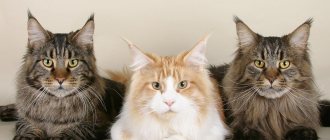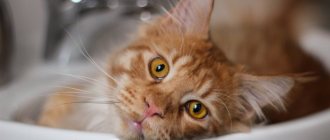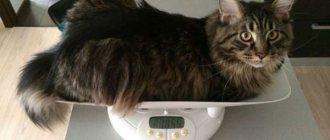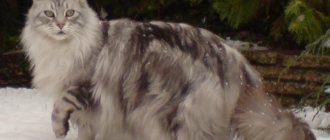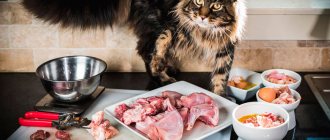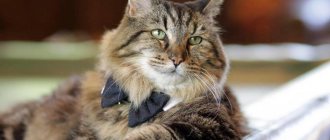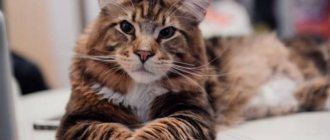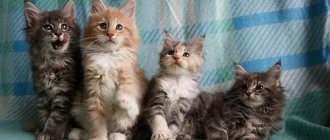Maine Coons know how to make an impression with their appearance - gigantic size, beautiful hair, tufted ears, powerful paws, dressed in “pants.”
At first glance, it may seem that these domestic lynxes require special living conditions. In fact, caring for a Maine Coon is not difficult if you know the habits of these animals and follow simple rules. The coon should not be kept in a small apartment - it is a large, active cat that requires living space, if only due to its rather large size. Animals of this breed are not cheap to keep, primarily due to the cost of food - Maine Coons require more of it than ordinary cats, but in general they are unpretentious, have good health and an easy-going character, which is important when caring for them.
Why are there no tassels on the ears?
People who want to become Maine Coon breeders are afraid to buy kittens without brushes, believing that they will be given a “damage” and not without reason, given the price for one baby. The bottom line is that the lack of sharp woolly ear tips is common in the breed. It is considered more of a norm than a deviation, and cats with an “anomaly” are allowed into exhibitions and competitions.
It is impossible to determine in advance whether Maine Coons have brushes. Genetics are designed in such a way that even mom and dad with tassels will not give a 100% chance of such a kitten appearing.
Features of the structure of the ears
The Maine Coon is rightfully considered unique among domestic cats; its head anatomy is similar to its wild relatives - the lynx. Wide, open, triangle-shaped ears with a cluster of hair at the tip are the hallmark of the Coon. The space between the ears does not exceed the length of the base of the ear, the shells are recessed. The surface of the internal cavity is delicate and pinkish, protected by a copious layer of thick hair. The structure of the muscles allows the ears to be sharply pressed to the head. The upper edge of the auricle begins slightly above the outer corner of the eye or at its level. A scruff grows around the head.
Does everyone have brushes?
Whether tassels will appear on your pet’s ears also depends on the diet, which must contain meat.
The genetics of the species suggests deviations from the norm, and the rules of competitions allow participation without brushes, equating both in determining authenticity. The absence of tufts on the ears of a Maine Coon in the first months of life does not mean that the kitten will not grow the treasured hair growths. This is facilitated by regular balanced nutrition according to all the rules of care and, of course, meat.
When do tassels appear?
Kittens of this breed acquire tassels for 5-6 months. life, there have been cases of delays of up to 9-10 months. This is due to the genetic characteristics of the parents and the ancestral line. Absence is possible due to a family member in the older generations. It is impossible to determine in advance which kitten will grow up and whether tassels will appear. New breeders are afraid to take on an animal without the hallmarks of a “real” breed.
This is interesting: Toilet for Maine Coon
What does a real Maine Coon look like?
Perhaps everyone who has even a vague idea of felinology has heard that these are one of the largest domestic cats, but not everyone knows what a true Maine Coon looks like. We'll figure out.
So the Maine Coon is a cat that boasts above average size. The length of the body from the nose to the tip of the tail can reach 120 cm, and the height at the withers is 42 cm.
The question of how much a Maine Coon weighs often causes heated debate. On the Internet you can find reviews from owners who talk about giants weighing almost 30 kg, but in reality, of course, no one has seen such miracles.
The weight of an adult cat of normal build, not suffering from obesity, varies from 7 to 12 kg. Due to their physiological characteristics, cats are more miniature, but still significantly heavier than representatives of other breeds. The mustachioed “lady”, as a rule, weighs from 4 to 8 kg. It is not surprising that the dimensions of these animals in the photo look impressive even in comparison with an adult, not to mention a child.
The given standards are average, and among Maine Coons there are sometimes real record-breaking giants. A handsome man named Omar from Melbourne, Australia, was even included in the Guinness Book of Records for his impressive size. This hero weighs like a medium-sized dog - as much as 14 kg, and the length of his body is 120 cm. Omar's owners say that their pet was a completely ordinary kitten, but by the time he was a year old he had grown to 10 kg. Considering that Maine Coons grow up to three years old, even at such a young age it was clear that the owners got an outstanding specimen.
Stewie the cat, a champion in length, lived in the breed's homeland in Reno, Nevada. The length of his body was a little more than 130 cm. Unfortunately, he lived only eight years, but his death had nothing to do with his size - the animal suffered from cancer.
Our country also has its own giant. His name is Garfield, and he lives in Moscow. The Muscovite's weight is 13 kg and length is 117 cm.
But let's return from exceptions to norms and talk about what a typical representative of the breed looks like. Maine Coons have a long body, shaped like a rectangle, with well-developed muscles and a wide chest.
The paws are high, powerful, round. Tufts of fur may grow between the pads of the toes, a reminder of survival in the snow and harsh climate of North America.
The neck is of medium length and covered with thick hair. Especially among breeders, the presence of a rich collar, similar to a lion's mane, is appreciated, although not required. On the back and sides the coat is longer and coarser than on the belly and “pants”. It has water-repellent properties and it is not so easy to wet the thick undercoat, which creates the effect of a thermos.
The head has a somewhat elongated shape, which is also a consequence of the evolution of the breed. Thanks to the elongated snout, excellent rat catchers easily caught prey even from hard-to-reach burrows. In males it is much larger. The muzzle should be full, well defined and box-shaped. Its structure resembles that of a tiger or lion. The “strong-willed” chin gives the representatives of the breed a characteristic brutal appearance.
The eyes are wide-set, slightly slanted, very expressive. The color of the iris varies from yellow to green. Blue or multi-colored eyes are only acceptable for white coats.
Large ears with dense cartilage, wide at the base and ending in tassels are another distinctive feature of the breed.
The breeders are especially proud of their long fluffy tail, which can reach up to 36 cm and is equal to the length of the body. Its fur is flowing, thick and dense. In the wild, the tail did an excellent job of protecting against cold and wind - animals wrapped it around their body and thus warmed up faster. In domestic cats, there is no need for an additional source of heat, but this part of the body is involved in the process of coordinating movements.
The listed characteristics help to distinguish a purebred Maine Coon from a mestizo and cats of similar breeds, for example, Siberian.
Coons are distinguished by a wide variety of colors. The classic ones, on which the others are based, are black (black marble), red (for the common man - red), blue (in other words - gray) and cream. Pure color without a pattern is rare and is called “solid”.
If you see the term “tabby” in the description of a kitten, this means that the color has stripes. This coloring is also called marble for its similarity with the pattern inherent in this material. Wide spiral stripes on the sides look very elegant. If we are talking about the so-called ticked tabby, then in this case the stripes are visible only on the paws, chest and/or muzzle, and not throughout the body.
In smoky representatives, the tips of the hairs are painted black or gray, which looks very impressive, especially in movement, when the animal’s skin literally shimmers.
If you love the tortoiseshell color, characterized by a combination of multi-colored spots, then you need to keep in mind that it is characteristic only of female animals, while cats are not characterized by the presence of more than two colors. By the way, there is a belief that such colorful cats bring happiness, luck and prosperity to their owners’ homes.
pixabay.com/
How to comb
Maine Coons have long coats that require special care. For this procedure you will need one or two combs with sparse and fine teeth. The tips of the teeth should be blunt and not sharp. It is also advisable to have a comb with long, sparse and rounded teeth, as well as a massage brush. You can use it to brush your cat before shows. The massage brush should also be used during the shedding period.
First, combing is carried out with a comb with sparse teeth, then with fine teeth. You need to comb in the direction of the fur. For convenience, you can divide the wool into partings. It is not recommended to scratch the neck area, hind legs and tail with a fine comb, as the hair there takes a long time to recover.
Long, thick fur sometimes develops tangles. They usually cluster on the chest, belly, hind legs, behind the ears and in the lower neck area. The tangles cause anxiety for the cat. They tighten the skin when wool is wrapped around the tangle. It must be divided into several parts and combed out. If this cannot be done, then you can carefully cut it off with nail scissors or tweezers. To do this, pull the tangle towards you and cut off the hairs directly under it.
It is better to brush your Maine Coon no more than four to five days. Brushing prevents severe hair loss and massages the hair. It is advisable to train your pet from an early age.
Choosing a kitten
The issue of choosing a kitten should be approached very responsibly and seriously. First of all, you should carefully study the breeder, based on reviews and recommendations from real buyers, and, under no circumstances, buy an animal from the first person you meet. The poultry market is most often a source of diseases, fleas and other things; buying an animal there is highly not recommended. After choosing a reputable breeder, you should adhere to the following rules:
- Carefully study the standards of this breed on the forums so as not to encounter a “fake” under any circumstances.
- The cost of such an animal is quite high, therefore, if a Maine Coon is offered at a reduced price, you should refuse the suspicious offer.
- It is advisable to look at the parents of your future kitten, but if the breeder refuses to show the mother and father of the kitten, then it is best to refuse the purchase too.
- A Maine Coon kitten can be adopted into a home no earlier than 12 weeks of age.
- Appearance must be healthy and meet breed standards.
- The kitten must be active, inquisitive, and friendly.
Prevention is the key to health
Caring for a Maine Coon primarily involves caring for the pet’s health. Coons, like cats of other breeds, must be vaccinated once a year against rabies, calcivirosis, panleukopenia and rhinotracheitis, and also periodically treated against ticks, fleas and helminths. Even if the animal does not leave the house, parasite larvae can be carried on the soles of shoes, and if the cat is taken to the country or it often participates in exhibitions, vaccination and deworming are vital for it.
Useful to read: Features of houses for Maine Coons
Maine Coons need vitamins for a healthy, beautiful coat, strong bones and teeth, and to maintain immunity. It is especially important that your pet receive vitamin supplements during growth, pregnancy, or illness. Special vitamin complexes for cats have been developed and can be purchased at veterinary pharmacies.
Feeding your cat pills is a problem for many Maine Coon owners. Animals spit out the medicine, and if it is mixed with a treat, they manage to eat the food and bypass the tablet. In this case, the medicine is turned into powder and combined with liquid food. If this does not help, there is only one way out - put the tablet in the cat’s mouth, on the root of the tongue, close its jaws with your hand and hold them until the animal swallows the medicine.
In addition, clean semi-long-haired Maine Coons need a special paste for removing hair. While licking itself, the Maine Coon swallows fur, it gets into the stomach, rolls into hair balls there and causes discomfort to the animal, leading to constipation, coughing, and even intestinal obstruction. The paste helps solve this problem, especially during shedding. It can be mixed with food, or it can be given to the cat separately.
History of breeding cats with ear tufts
If you look closely at cats of long-haired breeds, you will notice that almost all of them have small tassels at the ends of their ears. Although many cats have tassels that disappear as they grow older. However, there are several officially recognized breeds for which tassels are standard.
It is still not known exactly why cats need such decoration as tassels. There are three theories on this matter:
It is quite possible that the tassels serve as sound locators, because cats immediately react to sound by raising their ears to their maximum height
However, many breeders of cats with tassels on their ears are interested in the question: when did the very first cat appear that had such an unusual “decoration”? All currently recognized breeds have their own history, but officially the Norwegian Forest Cat can be considered one of the “oldest” cat breeds with tufted ears.
Official sources begin to mention the Norwegian forest cat from the 16th century. By the way, it is quite possible that it was she who became the ancestor of modern Maine Coons. However, illustrations of ancient Scandinavian culture clearly show that the Norwegians accompanied the Vikings long before the 16th century. For example, some legends and sagas say that the god Thor was always accompanied on his travels by a “fluffy forest beauty,” whose descriptions are very similar to the characteristics of a modern Norwegian cat.
Therefore, if you believe the Scandinavian sagas, the first representative of cats with tufts on their ears can be considered the Norwegian forest cat. It was she who became the progenitor of many existing breeds with tassels.
If Thor traveled on land in a chariot, then on sea voyages on a ship he was always accompanied by a fluffy cat
Nutrition - what and how to feed?
Proper feeding of Maine Coons is an important part of a cat’s healthy life. It is important to choose the right food and water containers for your pet.
It is necessary to take into account the fact that in the wild, the ancestors of cats, before drinking, try to clear the surface of the water from debris, fallen leaves, and twigs. At the same time, water is sprayed in different directions. Pets have retained this reflex. The Maine Coon may even knock over a bowl of water or move it along the floor. Therefore, the drinking container should be moderately heavy or fixed to the floor so that it does not move and cannot tip over.
The food bowl should be kept away from the water container. Otherwise, splashes that get into the food bowl can ruin the food. If the cat stays at home without its owners for a long time, it is better to purchase a water bottle. Water should always be fresh and clean.
Feeding Maine Coons has its own rules:
- You only need to feed your cat dry food of premium quality. It contains the necessary vitamins and various nutritional supplements that are important for the health and normal development of Maine Coons. Can be combined with canned food;
- if you feed with natural food, then the basis of the diet (at least 80%) should be meat and dairy products, vegetables and grains;
- If the cat's diet consists exclusively of natural products, it is necessary to regularly give vitamins;
- with a mixed diet, dry food should be the basis, and natural food should be additional.
What natural products can you feed your Maine Coon:
- meat: poultry, beef (raw and cooked), rabbit, lean lamb, chicken livers and hearts.
- vegetables: carrots, beets, cabbage, cucumbers, zucchini, pumpkin, tomatoes;
- hard cheese;
- eggs: yolk once or twice a week, boiled or raw;
- boiled sea fish, seaweed and other seafood;
- cereals, bran;
- fermented milk products: cottage cheese, yogurt, kefir, fermented baked milk (milk can only be given to kittens under 3 months of age);
- cereals: three to four times a week as an addition to boiled meat;
- sprouted grains: wheat and oats.
Important! It is prohibited to add salt, sugar, or spices to cat food.
It is strictly forbidden to give your pet beef and chicken bones, fatty pork, duck, goose, smoked meat products, sausages, sugar, potatoes, legumes, and chocolate.
Cats need to eat fresh greens periodically. To prevent your pet from being drawn to dusty, dirty grass during a walk, you need to sow grass seeds (wheat, oats) in a low, wide container (box) at home and allow the cat to eat the young sprouts.
If a cat is allergic to any of the food or products, the allergen should be removed from the diet.
Cat food should not be hot or cold. It should be at room temperature. Kittens need to grind their food. The kitten should eat at least 5 times a day. This principle must be maintained for up to 2 months. From six months onwards, the frequency of feedings is reduced to three times a day, and eight-month-old cats should be switched to two meals a day.
This is interesting: Photos of tortoiseshell Maine Coons
Caracal is a beautiful wild cat with tufted ears.
The homeland of the caracal is Africa, Arabia, India and Turkmenistan. Since ancient times, people have taken these wild cats with them on hunts. Sandy-red color, body length reaches 1 meter, including tail. High ears with tufts, which stand up straight when young, but droop as they get older.
The caracal has a balanced character and a friendly attitude towards people. These cats are easy to train, but they have a zealous love of freedom, so they need space.
If it is not possible to give the caracal the entire housing territory at its disposal, you can equip it with a large enclosure, providing it with logs, steps, houses, so that the cat has something to occupy itself with.
It is better not to house this four-legged animal next to large pets, because... a wayward animal may conflict with other inhabitants over territory.
You need to brush your cat often, at least 2 times a week. It is recommended to bathe as needed.
Food: raw poultry, beef, fish. You cannot give: pork, salty, spicy, fried, smoked meats and sausages, sweets, food from the table.
Source
Pet health - maintenance and care
Caring for a pet primarily involves paying attention to its health. To prevent your cat from getting sick and live a full life, it is necessary to take preventive measures. A domestic cat can catch the disease not only on a walk, but also at home. Infection or parasites may be brought in by shoes.
Prevention:
- once a year you need to be vaccinated against rabies, panleukopenia, calcivirosis, rhinotracheitis, chlamydia, infectious peritonitis, trichophytosis and microsporia (ringworm);
- treat wool with flea and tick preparations;
- take anthelmintics.
Bathing a raccoon cat
Bathing is an important part of Maine Coon care. Like all cats, representatives of this breed are not too fond of water treatments that involve getting their fur wet, although they enjoy playing with water. Coons are washed once every few months; urgent bathing is recommended if the pet is dirty or shedding (washing speeds up the shedding process - dead hairs are easier to remove). You should definitely bathe the animal before the exhibition.
For water procedures, you need shampoos (washing and tinting), conditioner, sponge, towel, hair dryer, as well as hair styling products (gels, creams, powders).
Bathing a Maine Coon goes like this:
- Fill a sink or small basin with warm water (not lower than +38°C). You can put a terry towel on the bottom so that the paws do not move apart and the cat does not get nervous.
- Holding the Maine Coon by the scruff of the neck, moisten the fur with a sponge and gently rub shampoo intended for long-haired cats into it, from the back to the tail.
- The cat should never be rubbed, otherwise the fur will become matted.
- Wash your hair without shampoo, do not allow detergent to get into the animal’s mouth, eyes and ears.
- You need to wash your Maine Coon's fur under a weak shower, from head to tail. Be sure to remove all the shampoo to make the coat squeak, otherwise skin irritation may occur. In addition, if the wool is poorly washed, it appears unkempt.
- Apply a special conditioner to the cat's fur, then rinse it thoroughly.
- Dry the animal with a towel, maybe a paper towel, so that the long fur does not get tangled from wiping.
- Wrap the Maine Coon in a large towel and take it to a warm, draft-free room.
- Dry the fur with a hairdryer (if the cat can tolerate the sound of it).
- Brush the cat. Pay special attention to the belly and “pants”, where the fur tends to curl in ringlets; it is advisable not to comb the tail at all, and comb the collar from bottom to top for fullness.
Maine Coon character
Despite their impressive, almost “lynx-like” size and the stern expression on their brutal faces, which give these cats a resemblance to their wild relatives, Maine Coons are one of the most benevolent creatures in the world. Aggression and vindictiveness are absolutely not inherent in these good-natured giants. A Maine Coon will never allow himself to pee in your slippers or ruin your bed. Representatives of this breed are intelligent from birth. Torn furniture and wallpaper or problems with the toilet are not about them.
The Maine Coon's character and behavior are often compared to those of a dog. These cats treat all family members equally favorably, but they will choose one person as the leader of the “pack”, whom they will follow closely, without annoying or bothering with excessive attention. Wherever you are, the cat will be nearby. It must be kept in mind that these animals do not tolerate loneliness and separation from their owners well, so leaving them alone for a long time is not a good idea.
At the same time, Maine Coons are full of self-esteem and have difficulty enduring “personal violence” when they are squeezed or grabbed against their will. The animal will endure violent manifestations of love until the last moment and, most likely, will not scratch or bite, but will certainly try to break free and leave. And most coons are not at all enthusiastic about sitting on laps (which is rather an advantage, given the considerable size of these cats), but they are always ready to comfortably sit next to their beloved owner and purr loudly.
Coons treat strangers neutrally - without fear, with a degree of curiosity, but also without ingratiation. These cats always evoke the sincere delight of others and the desire to communicate with them closer, but they will never hang around your feet and fawn on your guests, no matter how much they might want it. If a person comes to the house often, then over time the animal will get used to it and will take his visits for granted.
In various descriptions of the breed, you can often find the statement that representatives of this breed are silent, and instead of the usual cat meow, they make peculiar sounds similar to purring. Judging by the reviews of the owners, this is not always the case, and it is possible that you, like the author of this article, will come across a very talkative specimen.
Maine Coons have a relatively calm temperament and are not prone to destruction. But young animals, of course, love to frolic and run around. Future owners need to understand that due to its impressive dimensions, outdoor games often unwittingly end in destruction, so it is better to remove fragile things and flower pots in advance.
Coons are very smart, inquisitive, easily adapt to the lifestyle of their owners and get along well with children and other animals. With patience and persistence, they can be taught some commands. The main thing is to do everything in the form of a game and in such a way that it is interesting, first of all, to your pet.
pixabay.com/
Eyes, ears, teeth and claws - these are my documents
It is advisable to regularly inspect your Maine Coon's teeth to ensure that tartar does not form. If your cat eats dry food, you can brush its teeth once every two months; if it eats natural food, you can brush its teeth at least once a month. Coonam's teeth are cleaned with a special paste for cats using a children's toothbrush.
Caring for the eyes of a healthy cat is usually limited to daily wiping with a piece of cotton wool. If discharge appears, you can wipe your eyes with tea or a weak solution of boric acid.
The inside of a large weasel ear should be pink, clean, and free of black coating. If wax builds up, it can be gently removed with a cotton swab and Vaseline.
Useful to read: How to choose a suitable tray for Maine Coons?
If the Maine Coon is not supposed to be present at the exhibition today or tomorrow, it is better not to touch the claws - he will take care of their length himself using a scratching post. But if the claws have grown a lot, they can be trimmed with a special nail clipper or tweezers, very carefully, cutting off only the tip, strictly across, otherwise you can hit a blood vessel.
Particular care must be taken in shortening pigmented claws - the blood vessels are not visible through them, in addition, it should be remembered that the claws on the front paws are longer than on the hind paws. It is better to carry out the procedure together - one person holds the cat, and the other shortens the claws. After this cosmetic operation, you can polish the claws with a nail file. If an animal breaks a claw, it must be trimmed: a broken end can injure the cat's paw.
Lynx
Among the wild representatives of the cat family, there are also those who have tufts on their ears. A prominent representative is the lynx. There are several types of lynx. These include the Canadian, red, common and Iberian lynx.
A wild, powerful animal, it can reach a length of 130 centimeters and weigh up to 30 kg. In size, these wild cats are more like a medium-sized dog. Mature individuals, in addition to the characteristic tufts on the ears, have sideburns located along the edges of the predatory muzzle.
You need to understand that it is almost impossible to tame a lynx and subsequently keep it at home.
